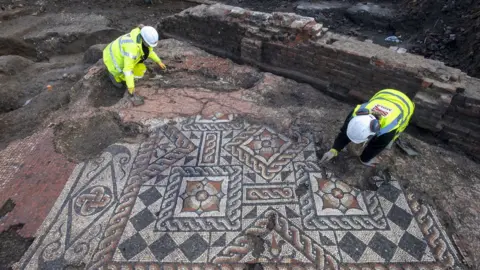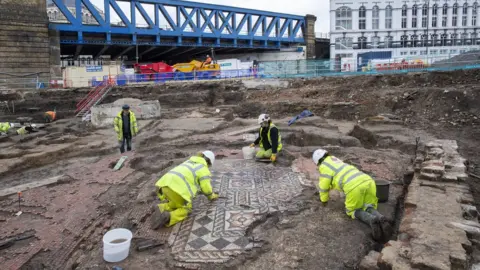London's largest Roman mosaic find for 50 years uncovered
 MOLA/Andy Choppin
MOLA/Andy ChoppinArchaeologists have uncovered the largest area of Roman mosaic found in London for more than half a century.
The two highly decorated panels feature large, colourful flowers, geometric patterns and elaborate motifs in a style unique to the capital.
It is thought it once decorated the floor of a Roman dining room.
The Museum of London Archaeology (MOLA) find came during excavations as part of the construction of a regeneration project near the Shard in Southwark.
 MOLA/Andy Chopping
MOLA/Andy ChoppingMOLA site supervisor, Antonietta Lerz, said: "This is a once-in-a-lifetime find in London. It has been a privilege to work on such a large site where the Roman archaeology is largely undisturbed by later activity - when the first flashes of colour started to emerge through the soil everyone on site was very excited."
It is made up of two panels, with the largest showing large, colourful flowers surrounded by bands of intertwining strands - a motif known as a guilloche.
There are also lotus flowers and several different geometric elements, including a pattern known as Solomon's knot, which is made of two interlaced loops.
Dr David Neal, former archaeologist with English Heritage and leading expert in Roman mosaic, has attributed this design to the "Acanthus group" - a team of mosaicists working in London who developed their own unique local style.
 MOLA/Andy Chopping
MOLA/Andy ChoppingWhile the largest mosaic panel can be dated to the late 2nd to early 3rd century AD, traces of an earlier mosaic underneath the one currently visible have been identified which shows the room was refurbished over the years.
It was located on the outskirts of Roman Londinium, an area centred on the north bank of the Thames which roughly corresponds to the modern City of London.
A spokesperson for MOLA added the room it was situated in would have contained dining couches, where people would have reclined to eat and it might have been part of a Roman mansio - an upmarket "motel" for state couriers and officials travelling to and from London.
The excavations are part of the Liberty of Southwark regeneration project, which will comprise of homes, workspace, shops and restaurants.
The mosaics will be carefully recorded and assessed by an expert team of conservators before being transported off-site, to enable more detailed conservation work to take place. Future plans for the public display of the mosaics are currently being determined.

Timeline for the site:
- AD 43: the Romans, led by emperor Claudius, invade Britain.
- AD 48-50: London (Londinium) is founded.
- AD 72: the eastern building currently interpreted as a private residence was built.
- AD 120-160: the building currently interpreted as a mansio was built.
- AD 175-225: probable date for the largest mosaic panel in the 'mansio'.
- 4th century AD: both buildings fall out of use.
- AD 410: end of Roman control over Britain.

Follow BBC London on Facebook, Twitter and Instagram. Send your story ideas to [email protected]
